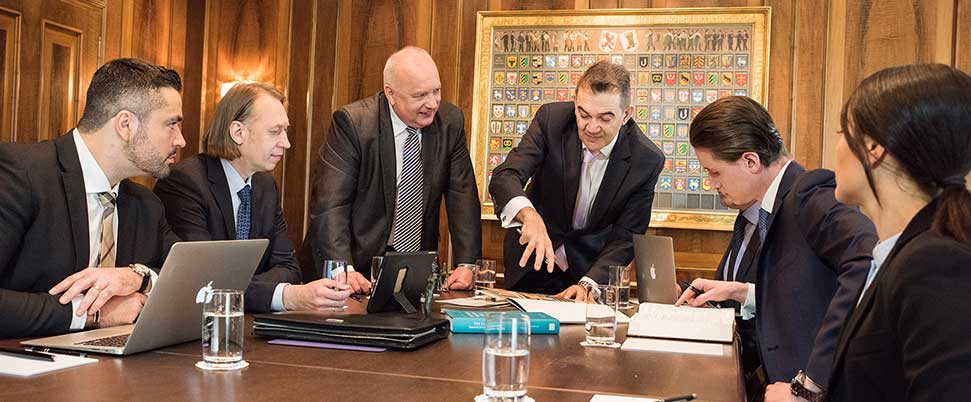Setting up a single-family office
An increasing number of wealthy families play with the thought of setting up a single-family office. Establishing a single-family office is, in fact, not that easy. Where do you start? What do you need to organise? Do you need to draft a family office business plan? Is there a best family office structure? How wealthy do you really need to be for a family office? Might the use of a multi-family office actually be a better solution?
In most jurisdictions, finding professional guidance on this complex topic is a challenge and even in more established jurisdictions holistic advice can be hard to find. As an introduction on how to do this we describe below our single-family office advisory process in short – “12 necessary steps for setting up a single-family office”. As true project managers we work together with you to implement the necessary modules and help you to establish your own unique family office.
Read further or contact us for more information about how to set up a single-family office.
Every family office is unique (to a certain extent…)
Every family is unique and therefore every single-family office will be unique. The process a family should follow when establishing a single-family office is, to the contrary, not unique. Many elements can be encountered in almost all single-family offices as wealthy families ultimately all face very similar challenges.
❝Our family office advisory process reflects global best practices❞
Families considering starting a family office should realise that a single-family office is a business as such, and therefore must be established and managed accordingly. Family offices that are not established professionally from the outset often become dysfunctional over time.
Every family needs to deliberate on the same strategic steps and take joint family decisions to come to the right customised outcome. In practice, it is the lack of such a systematic process and structured approach that causes things to go wrong. So, the process is almost the same for every family, but the outcome unique. The process is quite comparable to that of establishing a new commercial family business.
12 steps for setting up a single-family office
First a word of wisdom before you start the process. If it is not your objective to establish an exceptional family office, you should perhaps simply continue to cooperate with external advisors or use the services of a multi-family office – we can also help you select the right multi-family office for your specific needs.
Reflecting global best practices, Caputo & Partners Family Office Advisory has developed a comprehensive advisory process to support families all over the world with setting up a family office. Our process is split up in 12 dedicated modules to make sure a structured approach is followed.
How to set up a single-family office in 12 steps:
1. The family office objective
Setting up a single-family office is best started by drafting a single-family office charter, also referred to as a family office constitution. Through this document all involved family members decide and agree on the objectives of the family office.
A single-family office charter can be part of the overall family governance of the family.
2. Family involvement
Establishing the involvement of the family (members) in, for example, the single-family office leadership structure is very important and needs to be done at a relatively early stage. Will one of the family members be involved in the operational activity of the family office?
3. The assets which are managed by the family office
Which family assets are within the scope of activities of the family office and which are not? Which assets remain to be managed by the family directly (such as the family business)?
4. The services the family office provides
Each family needs to decide which services the family office will provide. Although for most single-family offices managing investments is a primary service, this is not necessarily the case for all of them.
5. Family office leadership structure
Every single-family office needs a leader: the Chief Executive Officer (CEO) of the family office. Recruiting a single-family office CEO can be extremely challenging. (Read more about this in the paragraph ‘common mistakes’.)
6. Drafting the family office business plan
A single-family office business plan should be drafted. A family office business plan is necessary to bring structure in the process of establishment.
7. Budget & costs of the single-family office
The establishment of a single-family office starts with pro forma budgeting. The family office needs to grow over time from a first pro forma budget to a formal yearly budget.
8. The family office jurisdiction
An analysis should be made to select the most suitable jurisdiction to establish and operate the family office. The location should suit the situation of the family members (the clients of the family office), but that is clearly not the only element to take into account.
9. The family office structure
The location of a single-family office and its legal structure go hand in hand. The legal family office structure should fit the jurisdiction. One important element to consider is how the activities of the family office will be financed.
10. Recruitment of family office staff
Recruiting and maintaining staff for a family office can be challenging. Staff is normally the largest cost element of the family office. Every single-family office needs to analyse the number of staff needed and their role in respect of the services the family office aims to provide.
11. (Operational) Infrastructure
Although not the most exciting topic, office space and everything related to it, such as computers, will need to be organised for the family office. One also has to consider how the family office will operate in practice.
12. IT, family office software & cyber security
Nowadays the technological side of a family office should not be underestimated. Running a family office without proper IT applications is impossible. Software should be acquired or outsourced.
Both control and risk management are extremely important elements in the process of operating a family office. As they are that important we do not consider them separate steps, but when working with us you find them integrated in (almost) all of our modules. At the bottom of this page you find additional information about how we support you.
Taking the first step

With the exception of the establishment of the family office objective – establishing a solid and appropriate family office governance framework at the start can prevent severe problems in the future – most steps need to be addressed ahead of time and/or taken simultaneously. This can make the whole process rather complex. Caputo & Partners has a long record of experience and provides understandable guidance and advice. We act as your project manager and sparring partner – together we get things done.
Just as a family business evolves over the years, so should a family office evolve through certain stages over a period of time. You should realise and accept that it is almost impossible to set up a completely outfitted and fully operational single-family office from scratch in a short time. Instead, you must lay a solid foundation and keep building and expanding on that over time.
Common mistakes
In practice, we experience that families find it rather difficult to approach the topic with a professional perspective. Below we mention some of the mistakes regularly made.
A professional process
Instead of defining the family office objective, drafting an initial business plan, preliminary budget and first framework of regulations, families tend to approach the topic completely ad hoc. Or they keep re-thinking it and discussing it within the family without any actual commitment. One of the reasons for this is that families simply behave differently when they discuss their private wealth instead of their business.
It is very risky when such an approach continues further down the road and the family office becomes even more complex as more generations get involved. A family office with a lack of governance will not operate effectively.
Starting a family office is not a “nice to have” exercise, a hobby, something you do under the motto: “well, let’s give it a try”. A single-family office is a professional business on its own, which needs to be established and managed highly professionally. Otherwise it is guaranteed to fail. The process of establishing one is rather complex. Using the support of a single-family office project manager, such as Caputo & Partners, during the process is advisable.
Hiring family office staff
Another common mistake made is the immediate appointment of a former employee, (former) banker of the family or other trusted advisor (such as your lawyer), as the family office CEO or CIO and giving him/her the task of establishing the family office for the family. Although there is usually a lot of trust between this person and the family, fact is that in most cases this person lacks experience in setting up and operating a single-family office.
Not organising a proper recruitment process for this/these crucial role(s) can turn out to be a mistake. You do not hear us say that you cannot hire such person, but it is highly advisable to have a selection of candidates and all candidates should be thoroughly compared and professionally assessed.
The chance that you, as a family, are already certain who the best person for the job is (and therefore do not consider other candidates) is statistically very small. One would never act like that when recruiting for important positions in the family business, but when a family establishes a single-family office we see it happen often.
Change is the only constant
A single-family office is not static but a dynamic structure. This is often forgotten. Families evolve and once a family office has been established, it needs to grow with, adapt to and evolve according to the needs and wishes of the family (members) and the ever changing external circumstances.
Making sure the family office is adaptive to change and remains effective can be extremely challenging. This is especially so when there is a transition to, or first time involvement of, the next generation. The family office staff and family members need to plan regularly and carefully for constant transition, otherwise there is a risk of losing the connection with the next generation.




